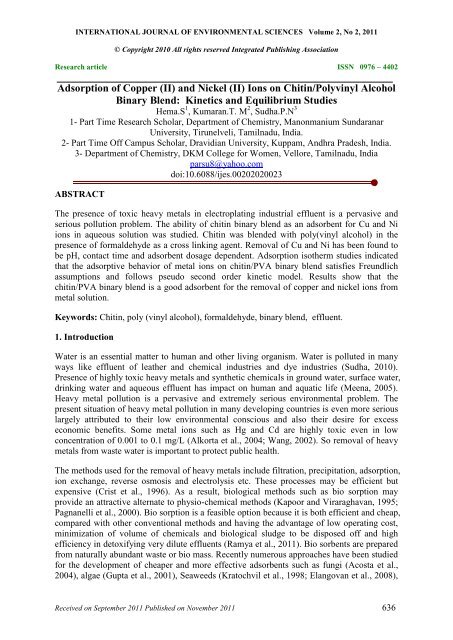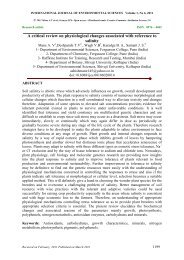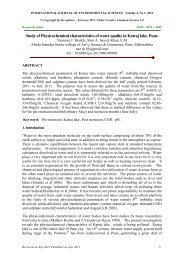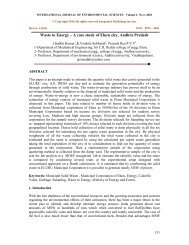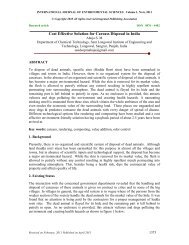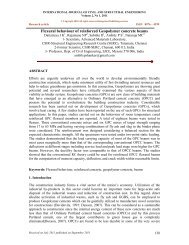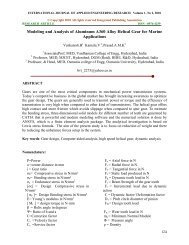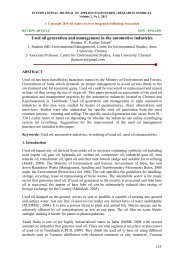Full text pdf - Integrated Publishing Association
Full text pdf - Integrated Publishing Association
Full text pdf - Integrated Publishing Association
You also want an ePaper? Increase the reach of your titles
YUMPU automatically turns print PDFs into web optimized ePapers that Google loves.
INTERNATIONAL JOURNAL OF ENVIRONMENTAL SCIENCES Volume 2, No 2, 2011<br />
© Copyright 2010 All rights reserved <strong>Integrated</strong> <strong>Publishing</strong> <strong>Association</strong><br />
Research article ISSN 0976 – 4402<br />
Adsorption of Copper (II) and Nickel (II) Ions on Chitin/Polyvinyl Alcohol<br />
Binary Blend: Kinetics and Equilibrium Studies<br />
Hema.S 1 , Kumaran.T. M 2 , Sudha.P.N 3<br />
1- Part Time Research Scholar, Department of Chemistry, Manonmanium Sundaranar<br />
University, Tirunelveli, Tamilnadu, India.<br />
2- Part Time Off Campus Scholar, Dravidian University, Kuppam, Andhra Pradesh, India.<br />
3- Department of Chemistry, DKM College for Women, Vellore, Tamilnadu, India<br />
parsu8@yahoo.com<br />
doi:10.6088/ijes.00202020023<br />
ABSTRACT<br />
The presence of toxic heavy metals in electroplating industrial effluent is a pervasive and<br />
serious pollution problem. The ability of chitin binary blend as an adsorbent for Cu and Ni<br />
ions in aqueous solution was studied. Chitin was blended with poly(vinyl alcohol) in the<br />
presence of formaldehyde as a cross linking agent. Removal of Cu and Ni has been found to<br />
be pH, contact time and adsorbent dosage dependent. Adsorption isotherm studies indicated<br />
that the adsorptive behavior of metal ions on chitin/PVA binary blend satisfies Freundlich<br />
assumptions and follows pseudo second order kinetic model. Results show that the<br />
chitin/PVA binary blend is a good adsorbent for the removal of copper and nickel ions from<br />
metal solution.<br />
Keywords: Chitin, poly (vinyl alcohol), formaldehyde, binary blend, effluent.<br />
1. Introduction<br />
Water is an essential matter to human and other living organism. Water is polluted in many<br />
ways like effluent of leather and chemical industries and dye industries (Sudha, 2010).<br />
Presence of highly toxic heavy metals and synthetic chemicals in ground water, surface water,<br />
drinking water and aqueous effluent has impact on human and aquatic life (Meena, 2005).<br />
Heavy metal pollution is a pervasive and extremely serious environmental problem. The<br />
present situation of heavy metal pollution in many developing countries is even more serious<br />
largely attributed to their low environmental conscious and also their desire for excess<br />
economic benefits. Some metal ions such as Hg and Cd are highly toxic even in low<br />
concentration of 0.001 to 0.1 mg/L (Alkorta et al., 2004; Wang, 2002). So removal of heavy<br />
metals from waste water is important to protect public health.<br />
The methods used for the removal of heavy metals include filtration, precipitation, adsorption,<br />
ion exchange, reverse osmosis and electrolysis etc. These processes may be efficient but<br />
expensive (Crist et al., 1996). As a result, biological methods such as bio sorption may<br />
provide an attractive alternate to physio-chemical methods (Kapoor and Viraraghavan, 1995;<br />
Pagnanelli et al., 2000). Bio sorption is a feasible option because it is both efficient and cheap,<br />
compared with other conventional methods and having the advantage of low operating cost,<br />
minimization of volume of chemicals and biological sludge to be disposed off and high<br />
efficiency in detoxifying very dilute effluents (Ramya et al., 2011). Bio sorbents are prepared<br />
from naturally abundant waste or bio mass. Recently numerous approaches have been studied<br />
for the development of cheaper and more effective adsorbents such as fungi (Acosta et al.,<br />
2004), algae (Gupta et al., 2001), Seaweeds (Kratochvil et al., 1998; Elangovan et al., 2008),<br />
Received on September 2011 Published on November 2011 636
Adsorption of Copper (II) and Nickel (II) Ions on Chitin/Polyvinyl Alcohol Binary Blend: Kinetics and<br />
Equilibrium Studies<br />
Micro organisms (Sahin and Ozturk, 2005; Fan et al., 2008) have been used for water<br />
treatment. Polysaccharides are renewable resources which are currently being explored<br />
intensively for their application in water treatment (Gupta and Ravikumar, 2000).<br />
Among various polysaccharide compounds identified, chitin and their derivatives (Ravikumar,<br />
2000) deserved particular attention. This polysaccharides are abundant, renewable bio<br />
degradable and are the best choice in water treatment (Bolto, 1995). Chitin is one of the most<br />
abundant polysaccharide in nature (Knorr, 1982) next to cellulose. It can be found in animals,<br />
Fungi, mushrooms and yeasts (Roberts, 1992). Chitin can be described as a bio polymer<br />
composed of N-acetyl-D-glucosamine , a chemical structure very close to cellulose except<br />
that the hydroxyl group in C-2 of cellulose being replaced by an acetamido group in chitin. It<br />
is worth noting that both chitin and chitosan are recogonized as excellent metal ligand,<br />
forming stable complexes with many metal ions (Chui et al., 1996). Chitin is superior to<br />
chitosan especially in the bio medical fields due to the fact that acetamido group in chitin is<br />
similar to the amide linkage of protein in living tissues (Muzzareli, 1985).<br />
Blending is an important process for developing industrial applications of polymeric<br />
materials and compatibility among components has a marked influence on the resulting<br />
physical properties of polymer blends (Folkes and Hope, 1985). Blending a natural polymer<br />
with a synthetic one seems to be a better way of preparing polymeric alloys to meet specific<br />
needs. Blending improves the mechanical and thermal properties of the individual polymer.<br />
Poly(vinyl alcohol) is a non toxic, water soluble, synthetic polymer with its excellent film<br />
forming properties. PVA is a good candidate for use as membranes and hydro gels (Hassan<br />
and Peppas, 2000; Kim et al., 1992).<br />
The aim of this study is to prepare binary blend of chitin with poly (vinyl alcohol) in the<br />
presence of formaldehyde as a cross linking agent. In the present study, the equilibrium<br />
studies of Cu (II) and Ni (II) were investigated. Experiments have been done as a function of<br />
pH, adsorbent dose and contact time. The adsorption capacity of Cu(II) and Ni(II) by<br />
chitin/PVA binary blend were determined using Langmuir and Freundlich equation and<br />
kinetic studies were done to identify the type of adsorption. Hence this information will be<br />
useful for further water treatment application.<br />
2. Materials and Method<br />
2.1. Materials<br />
Chitin was kindly gifted by India Sea Food, Cochin, Kerala, India. Poly(vinyl alcohol),<br />
formaldehyde and other chemicals used in the experiments are of analytical grade.<br />
2.2. Preparation of chitin binary blend:<br />
Chitin/poly (vinyl alcohol) binary blend film was prepared by mixing solutions of chitin with<br />
poly (vinyl alcohol) in the ratio 1:1. Chitin was dissolved in 15% of lithium chloride<br />
dissolved in DMSO. Poly (vinyl alcohol) was dissolved in water. These two polymers were<br />
blended in the ratio 1:1 and 10% of formaldehyde was added as a cross linking agent. The<br />
solution was stirred well and kept overnight at 5 °C to get dry film.<br />
2.3. Experimental process of removal of copper and nickel<br />
Hema. S, Kumaran. T. M, Sudha. P. N<br />
International Journal of Environmental Sciences Volume 2 No.2, 2011<br />
637
% Removal of Cu(II) and Ni(II)<br />
Adsorption of Copper (II) and Nickel (II) Ions on Chitin/Polyvinyl Alcohol Binary Blend: Kinetics and<br />
Equilibrium Studies<br />
Batch studies were performed with different concentrations of nickel chloride and copper<br />
sulphate to investigate the amount of adsorption. The extent of removal of the two metal ions<br />
was investigated separately by changing the pH, adsorbent dose, and contact time. The pH of<br />
the solution was adjusted to different values with either NaoH or Hcl. The stoppered bottles<br />
were agitated at 30°C by orbital shaker at fixed speed, 160 rpm for various time intervals.<br />
The adsorbates were separated by Whattman filter paper and supernatant liquid was analyzed<br />
for residual concentration of the metal ion by atomic adsorption spectrophotometer. Triplicate<br />
runs differing by less than 1% of all the tests were achieved assuring the reproducibility of<br />
the obtained results.<br />
3. Results and Discussion<br />
3.1. Factors influencing the adsorption of Cu(II) and Ni(II) ions<br />
Several parameters which influences the adsorption such as adsorbent dose, contact time, pH<br />
were investigated<br />
3.1.1. Effect of adsorbent dose<br />
Adsorption of Cu(II) and Ni(II) was found to depend on the adsorbent dose. So adsorption of<br />
Cu(II) and Ni(II) was studied by varying the adsorbent dose from 1gm to 5gm, while other<br />
parameters like time, and pH were kept constant. From Figure 1, it is evident that adsorption<br />
of Cu(II) and Ni(II) ions was generally increased with increased in the adsorbent dose. This is<br />
because higher dosage of adsorbent increases the surface area, thereby increasing the greater<br />
availability of exchangeable sites for the metal ions to get adsorbed. From the results it was<br />
evident that there was no further increase in adsorption when the adsorbent dose reached<br />
5gm/L. The maximum % removal of Cu(II) was about 90.09% at the dosage of 5gm and that<br />
for Ni(II) was about 89% at the same dose. Hence 5 gm was concluded as the optimum<br />
adsorbent dose. This results also suggests that after a certain dose of adsorbent, the adsorption<br />
of metal ion reaches maximum and hence the amount of ions bound on the adsorbent site and<br />
the amount of free ions in the solution remains constant with further increase in the adsorbent<br />
dose.<br />
90<br />
Cu(II)<br />
Ni(II)<br />
80<br />
70<br />
60<br />
50<br />
40<br />
1 2 3 4 5<br />
Adsorbent of Dose (gms)<br />
Figure 1: Percentage removal of Cu(II) and Ni(II) ions using chitin/PVA blend with different<br />
adsorbent dosage.<br />
3.1.2. Effect of contact time<br />
Adsorption of Cu(II) and Ni(II) was studied by varying the contact time from 60 minutes to<br />
240 minutes (1hr – 4hr) by keeping pH and adsorbent dose as constant. Results revealed that<br />
Hema. S, Kumaran. T. M, Sudha. P. N<br />
International Journal of Environmental Sciences Volume 2 No.2, 2011<br />
638
% Removal of Cu(II) and Ni(II)<br />
% Removal of Cu(II) and Ni(II)<br />
Adsorption of Copper (II) and Nickel (II) Ions on Chitin/Polyvinyl Alcohol Binary Blend: Kinetics and<br />
Equilibrium Studies<br />
metal ion removal was increased with increase in contact time before equilibrium was<br />
reached (Figure 2). There was increase in the adsorption of Ni(II) from 58% to 73% when the<br />
time was increased from 60 minutes to 120 min. The percentage removal of Ni(II) remains<br />
constant (88%) at 240 min which shows that the equilibrium was attained even at 240 minute<br />
itself. Likewise, for the metal ion Cu(II) the rate of adsorption was increased with increase in<br />
the contact time from 1hr to 2hrs and remained constant (83%) at 4hrs. Thus from the results<br />
it is evident that the optimum contact time for maximum removal of Cu(II) was 240 min. The<br />
time parameter is a important factor because it brings us economical waste water treatment<br />
system.<br />
90<br />
85<br />
Cu(II)<br />
Ni(II)<br />
80<br />
75<br />
70<br />
65<br />
60<br />
55<br />
50<br />
45<br />
1.0 1.5 2.0 2.5 3.0 3.5 4.0<br />
Time (Hr)<br />
Figure 2: Percentage removal of Ni(II) and Cu(II) ions by chitin/PVA blend at different<br />
contact time.<br />
3.1.3. Effect of pH<br />
PH is an important parameter which obviously influences the removal efficiency of Cu(II)<br />
and Ni(II) ions from the solution. The results showed that Ni(II) and Cu(II) removal was<br />
maximum at a pH around 5 and decreases beyond 5 which is shown in Figure 3. The<br />
maximum removal of Ni(II) was about 82.3% at a pH 5 and that of Cu(II) was about 72% at<br />
the same pH. When the pH was greater than 5, copper ions starts precipitating as Cu(OH) 2 ,<br />
and this fact was confirmed by Wang and Qin (2005). Decrease in adsorption at higher pH<br />
(pH>6) is due to the formation of soluble hydroxyl complexes (Meena et al., 2003). So the<br />
adsorption of Cu(II) and Ni(II) was found to depend mainly on solution pH.<br />
85<br />
80<br />
Cu(II)<br />
Ni(II)<br />
75<br />
70<br />
65<br />
60<br />
55<br />
50<br />
45<br />
40<br />
35<br />
30<br />
4 5 6 7 8<br />
pH<br />
Hema. S, Kumaran. T. M, Sudha. P. N<br />
International Journal of Environmental Sciences Volume 2 No.2, 2011<br />
639
Cads(mg/g)<br />
Adsorption of Copper (II) and Nickel (II) Ions on Chitin/Polyvinyl Alcohol Binary Blend: Kinetics and<br />
Equilibrium Studies<br />
Figure 3: Percentage removal of Ni(II) and Cu(II) ions by chitin/PVA blend at different pH.<br />
3.2. Adsorption Isotherm<br />
3.2.1. Langmuir model<br />
Adsorption isotherm is important to describe how solutes interact with adsorbent. The<br />
Langmuir and Freundlich models are often used to describe equilibrium sorption isotherms.<br />
The most widely used Langmuir equation is valid for monolayer sorption on to a surface with<br />
a finite number of identical sites. The Langmuir equation has been frequently used to give the<br />
sorption equilibrium (Koumanova et al., 2002). The linearized Langmuir isotherm is as<br />
follows<br />
where<br />
C eq /C ads = bc eq /K L + 1/K L (1)<br />
C max = K L /b (2)<br />
C eq = equilibrium concentration of metal ion in solution (mg/dm 3 )<br />
C ads = amount of metal ions adsorbed (mg/g)<br />
K L , b = Langmuir constants (dm 3 /g)<br />
C max<br />
= Maximum metal ion adsorption on to 1g of adsorbent (mg/g)<br />
The constant K L in Langmuir equation can be used to calculate the enthalpy of adsorption<br />
(Schmuchi et al., 2001). A plot of C eq /C ads against C eq gives the values of K L and b (Table 1).<br />
Figures 4 and 5 explain the isotherm of sorption Cu(II) and Ni(II) ions by chitin PVA blend.<br />
The isotherm is characterized by the initial region, which is represented as being concave to<br />
the concentration axis. The isotherm begins to reach a plateau , which can typically be<br />
described by the Langmuir isotherm (Parfitt and Rochester, 1983).<br />
800<br />
600<br />
400<br />
200<br />
0<br />
0 100 200 300 400 500<br />
C eq (mg/dm 3 )<br />
Figure 4: Isotherm for the adsorption of Cu(II) ions onto chitin/PVAblend.<br />
Hema. S, Kumaran. T. M, Sudha. P. N<br />
International Journal of Environmental Sciences Volume 2 No.2, 2011<br />
640
Ceq/ Cads(gm/dm3)<br />
Cads(mg/g)<br />
Ceq/ Cads(gm/dm3)<br />
Adsorption of Copper (II) and Nickel (II) Ions on Chitin/Polyvinyl Alcohol Binary Blend: Kinetics and<br />
Equilibrium Studies<br />
600<br />
400<br />
200<br />
0<br />
0 100 200 300 400 500<br />
C eq (mg/dm 3 )<br />
Figure 5: Isotherm for the adsorption of Ni(II) ions onto chitin/PVA blend.<br />
The Langmuir equation was used to describe the data derived from the adsorption of<br />
Cu(II)and Ni(II) ions by chitin/PVA binary blend adsorbent over the entire concentration<br />
range studies (Figures 6 and 7).<br />
4.0<br />
3.5<br />
3.0<br />
2.5<br />
2.0<br />
1.5<br />
0 100 200 300 400 500<br />
Ceq (mg/dm 3 )<br />
Figure 6: Langmuir plot for the adsorption of Cu(II) ions by chitin/PVA blend.<br />
5<br />
4<br />
3<br />
2<br />
1<br />
0<br />
0 100 200 300 400 500<br />
C eq (mg/dm 3 )<br />
. Figure 7: Langmuir plot for the adsorption of Ni(II) ions by chitin/PVA blend.<br />
Hema. S, Kumaran. T. M, Sudha. P. N<br />
International Journal of Environmental Sciences Volume 2 No.2, 2011<br />
641
Adsorption of Copper (II) and Nickel (II) Ions on Chitin/Polyvinyl Alcohol Binary Blend: Kinetics and<br />
Equilibrium Studies<br />
Table 1: Langmuir adsorption isotherm constants and C max value<br />
Metal ions<br />
Langmuir constants<br />
Cu(II) K L (dm 3 /g) b(dm 3 /mg) C max (mg/g) R 2<br />
Ni(II) 2.183 0.003266 668.40 0.9403<br />
1.545 0.005641 273.88 0.9382<br />
R L the separation factor is used to predict if an adsorption system is “favourable” or “un<br />
favourable” (Ngah and Musa, 1998). R L is given by<br />
R L = 1/1+bC f (3)<br />
where C f = Final concentration of the metal ion (mg/dm 3 )<br />
b = Langmuir adsorption equilibrium constant (dm 3 /g)<br />
The parameter indicates the isotherm shape according to Table 2. Table 3 explains the<br />
R L values for different final concentration of Cu(II) and Ni(II) ions. If the R L values are in the<br />
range of 0
log qe<br />
Adsorption of Copper (II) and Nickel (II) Ions on Chitin/Polyvinyl Alcohol Binary Blend: Kinetics and<br />
Equilibrium Studies<br />
3.2.2. Freundlich model<br />
The widely used empirical Freundlich equation based on a heterogeneous surface is given by<br />
log q e = log K F + 1/n log C e (4)<br />
where K F , n are Freundlich constants (mg/g). K F and n can be determined from linear plot of<br />
log q e against log C e . The linear regression plot of Freundlich isotherm for Cu(II) and Ni(II)<br />
uptake by chitin/PVA blend is shown in the Figures 8 and 9.<br />
A comparison between Langmuir and Freundlich isotherm models is tabulated in Table 4.<br />
The Freundlich constants K F, n, and R 2 determined from model indicated that this model<br />
better describes the adsorption process in comparison to the Langmuir model.<br />
3.0<br />
2.5<br />
2.0<br />
1.5<br />
1.0<br />
0 1 2 3<br />
log C e<br />
Figure 8: Freundlich plot for the adsorption of Cu(II) ions by chitin/PVA blend.<br />
3.0<br />
log q e<br />
2.5<br />
2.0<br />
1.5<br />
0 1 2 3<br />
log C e<br />
Figure 9: Freundlich plot for the adsorption of Ni(II) ions by chitin/PVA blend.<br />
Hema. S, Kumaran. T. M, Sudha. P. N<br />
International Journal of Environmental Sciences Volume 2 No.2, 2011<br />
643
log(qe-qt)<br />
Adsorption of Copper (II) and Nickel (II) Ions on Chitin/Polyvinyl Alcohol Binary Blend: Kinetics and<br />
Equilibrium Studies<br />
Table 4: Comparison of Langmuir and Freundlich isotherm parameters<br />
Metal<br />
ions<br />
Langmuir isotherm<br />
Freundlich isotherm parameters<br />
parameters<br />
Q max (mg/g) K L (dm 3 /g) b(dm 3 /g) R 2 K F (mg/g) n R 2<br />
Cu(II) 668.40 2.183 0.003266 0.9403 3.665 1.180 0.9986<br />
Ni(II) 273.88 1.545 0.005641 0.9382 8.3965 1.46 0.9971<br />
3.3. Kinetic studies of adsorption<br />
In order to study the controlling mechanism of adsorption process such as mass transfer and<br />
chemical reaction, the first order and second order equation were used to test the<br />
experimental data (Chiou, 2003, Chiou and Li, 2002) is given as<br />
log (q e – q t ) = log q e – k 1 t/2.303 (5)<br />
Where q e and q t are the amount of Cu(II) and Ni(II) adsorbed on adsorbent (mg/g) at<br />
equilibrium and at time t, respectively, k 1 is the rate constant of first order adsorption min -1 .<br />
The straight line plots of log (q e –q t ) against t was used to determine the rate constant k 1, and<br />
correlation coefficient R 2 values of Cu(II) and Ni(II) under different concentration range were<br />
calculated from these plots (Figures 10 and 11). The second order equation may be expressed<br />
as (Sag 2002, Wu et al., 2000)<br />
t/q t = 1/k 2 . q e 2 + 1/q e (6)<br />
where k 2 is the rate constant of second order adsorption (g mg -1 min -1 ). The straight line plot<br />
of t/q t against t have been tested to obtain rate parameters and it suggests the applicability of<br />
this kinetic model to fit the experimental data (Figures 12 and 13).<br />
1.5<br />
1.0<br />
0.5<br />
0.0<br />
-0.5<br />
100 200 300<br />
t(min)<br />
-1.0<br />
Figure 10: Pseudo-first-order sorption kinetic plot of Cu (II) on chitin/PVA binary blend.<br />
Hema. S, Kumaran. T. M, Sudha. P. N<br />
International Journal of Environmental Sciences Volume 2 No.2, 2011<br />
644
t/qt(min g mg -1 )<br />
log(qe-qt)<br />
t/qt(min g/mg)<br />
Adsorption of Copper (II) and Nickel (II) Ions on Chitin/Polyvinyl Alcohol Binary Blend: Kinetics and<br />
Equilibrium Studies<br />
1.0<br />
0.5<br />
0.0<br />
-0.5<br />
100 200 300<br />
t(min)<br />
-1.0<br />
-1.5<br />
Figure 11: Pseudo-first-order sorption kinetic plot of Ni(II) on chitin/PVA binary blend.<br />
6<br />
4<br />
2<br />
0<br />
0 100 200 300<br />
t(min)<br />
Figure 12: Pseudo-second -order sorption kinetic plot of Cu (II) on chitin/PVA binary blend.<br />
8<br />
6<br />
4<br />
2<br />
0<br />
0 100 200 300<br />
t(min)<br />
Figure 13: Pseudo-second-order sorption kinetic plot of Ni (II) on chitin/PVA binary blend.<br />
Hema. S, Kumaran. T. M, Sudha. P. N<br />
International Journal of Environmental Sciences Volume 2 No.2, 2011<br />
645
Adsorption of Copper (II) and Nickel (II) Ions on Chitin/Polyvinyl Alcohol Binary Blend: Kinetics and<br />
Equilibrium Studies<br />
Metal<br />
ions<br />
Table 5: Comparison between pseudo-first-order and pseudo-second-order kinetic<br />
models for Cu(II) and Ni(II) sorption by chitin/PVA binary blend.<br />
Pseudo first order<br />
Kinetics<br />
Q e (mg/g) k 1 x10 -2<br />
Experimental Values<br />
Pseudo second order<br />
Kinetics<br />
min -1 (g/mg/min)<br />
R 2 Q e (mg/g) Q e (mg/g) k 2<br />
Cu(II) 156.10 9.5 0.9057 39.4 65.4 0.01783 0.9896<br />
Ni(II) 117.6 9.1 0.9092 32.2 51.59 0.02035 0.9990<br />
R 2<br />
The results of the kinetic parameters for Cu(II) and Ni(II) adsorption are given in Table 5.<br />
Based on the correlation coefficients, the adsorption of Cu(II) and Ni(II) is well described by<br />
the second order equation. In many cases, the first order equation does not fit well to the<br />
whole range of contact time and is generally applicable over the initial stage of adsorption<br />
process (Mc Kay, 1999). In many cases, the second order equation correlates well to the<br />
adsorption behavior may involve valency forces through sharing of electrons between metal<br />
cations and adsorbent.<br />
4. Conclusion<br />
The bio polymer chitin was blended with poly(vinyl alcohol) in the ratio 1:1 using<br />
formaldehyde as a cross linking agent. The prepared blend was subjected to adsorption<br />
studies and the results showed that the adsorbent dose, contact time, and pH had a marked<br />
influence on the removal of Cu(II) and Ni(II) ions from metal solution. Atomic adsorption<br />
studies were done to examine the extent of adsorption of Cu(II) and Ni(II) by chitin/PVA<br />
blend. The adsorption isotherm could be well fitted by Freundlich equation. The adsorption<br />
process could be best described by second order equation. It can be concluded that<br />
chitin/PVA binary blend is an effective adsorbent for the collection of Cu(II) and Ni(II) from<br />
waste water.<br />
Acknowledgement<br />
The Authors thank the authorities of DKM college, Thiruvalluvar University, Vellore,<br />
Tamilnadu, India for their support.<br />
5. References<br />
1. Acosta, R. I., Rodriguez, X., Guiterrez, C., and Motctezuma, G (2004), “Bio<br />
sorption of Chromium (VI) from aqueous solutions on to fungal biomass”, Bio<br />
Inorganic Chemistry Applied Journal, 2(1), pp 1-7<br />
2. Alkorta, I., Hernandez-Allica, J., Becerril, J. M., Amezaga, I., Albiza, I., and<br />
Garbisu, C (2004), “Recent findings on the phytoremediation of soils contaminated<br />
with environmentally toxic heavy metals and mettaloids such as zinc, cadmium,<br />
lead, and arsenic”, Reviews in Environmental Science and Technology, 3(1), pp<br />
71-90<br />
3. Bolto, B. A (1995), “Soluble polymers in water purification”, Programme Polymer<br />
Science, 20, pp 987-1041<br />
Hema. S, Kumaran. T. M, Sudha. P. N<br />
International Journal of Environmental Sciences Volume 2 No.2, 2011<br />
646
Adsorption of Copper (II) and Nickel (II) Ions on Chitin/Polyvinyl Alcohol Binary Blend: Kinetics and<br />
Equilibrium Studies<br />
4. Chiou, M. S., and Li, H. Y (2002), “Equilibrium and kinetic modeling of adsorption<br />
of reactive dye on cross linked chitosan beads”, Journal of Hazardous materials, 93,<br />
pp 233-248<br />
5. Chiou, M. S., and Li, H. Y (2003), “Adsorption behaviour of reactive dye in<br />
aqueous solution on chemical cross linked chitosan beads”, Chemosphere, 50, pp<br />
1095- 1105<br />
6. Chui, V. W. D., Mok, K. W., Ng, C. Y., Luong, B. P., and Ma, K. K (1996),<br />
“Removal and recovery of copper(II), chromium(II) and nickel(II) from solution<br />
using crude shrimp chitin packed in small columns”, Environmental International,<br />
30(8), pp 468-8<br />
7. Elangovan, R., Philip, L., and Chandraraj, K (2008), “Bio sorption of chromium<br />
species by aquatic weeds: Kinetics and mechanism studies”, Journal of Hazardous<br />
Materials,152, pp 100-112.<br />
8. Fan, T., Liu, Y., Feng, B., Zeng, G., Yang, C., Zhou, M., Tan, Z., and Wang, X<br />
(2008), “Bio sorption of cadmium(II), zinc(II), and lead(II) by Penicillium<br />
Simplicissimum: Isotherm, kinetics, and thermodynamics”, Journal of Hazardous<br />
Materials, 160, pp 655-661<br />
9. M. H. Folkes, and P. S. Hope (1985), “Polymer Blend and Alloys”, Chapman and<br />
Hall, London, pp 430-440<br />
10. Gupta, K. C., and Ravikumar, M. N. V (2000), “Preparation characterization and<br />
release profiles of pH sensitive chitosan beads”, Polymer International, 49, pp 141-<br />
146<br />
11. Gupta, V. K., Shrivastava, A. K., and Jain, N (2001), “Bio sorption of chromium<br />
(VI) from aqueous solution by green algae spirogyra species”, Water Resource, 35,<br />
pp 4079-4085<br />
12. Hassan, C. M., and Peppas, N. A (2000), “Cellular freeze/thawed PVA hydrogels”,<br />
Journal of Applied Polymer Science, 76, pp 2075-2079<br />
13. Kapoor, A., and Viraraghavan, J (1995), “Fungal bio sorption an alternative option<br />
for heavy metal bearing waste water”, A Review in Bio Resource Technology,<br />
53(3), pp 195-206<br />
14. Kim, J. H., Lee, Y. M., and Kim, K. Y (1992), “Rheological study of<br />
chitosan/agar/poly vinyl alcohol blend solution”, Journal of Applied Polymer<br />
Science, 44, pp 1823-1828<br />
15. Knorr, D (1982), “Functional properties of chitin and chitosan”, Journal of Food<br />
Science, 47, pp 593-595<br />
16. Koumanova, B., Peeva, P., Allen, S. J., Gallgher, K. A., and Healy, M. G (2002),<br />
“Biosorption from aqueous solutions by egg shell membranes and rhizopus oryzae:<br />
Equilibrium and Kinetic studies”, Journal of Chemical Technology and<br />
Biotechnology, 77, pp 539-545<br />
Hema. S, Kumaran. T. M, Sudha. P. N<br />
International Journal of Environmental Sciences Volume 2 No.2, 2011<br />
647
Adsorption of Copper (II) and Nickel (II) Ions on Chitin/Polyvinyl Alcohol Binary Blend: Kinetics and<br />
Equilibrium Studies<br />
17. Kratochvil, D., Pimentel, P., and Volesky, B (1998), “Trivalent and hexavalent<br />
chromium by seaweed bio sorbent”, Environmental Science and Technology, 32,<br />
pp 2693-2698<br />
18. Mc Kay, G., and HO, Y. S (1999), “The sorption of lead (II) ions on peat”, Water<br />
Resource, 33, pp 578-584<br />
19. Meena, A. K., Mishra, G. S., Kumar, S., Rajagopal, C., and Nagar, P. N (2003),<br />
“Adsorption of Ni(II) and Zn(II) from aqueous solution by chemically treated<br />
activated carbon”, in National conference on carbon (Indo – carbon 2003)<br />
(DMSRDE, Kanpur), 31, pp 31-140<br />
20. Meena. A. K (2005), “Studies on treatment of contaminated water containing heavy<br />
metals”, in Jaipur and Pali, Ph. D. Thesis, University of Rajasthan, Jaipur.<br />
21. R. A. A. Muzzareli (1985), “Encyclopia of Polymer Science and Engineering”, Vol.<br />
3, Wiley, Newyork, pp 430-440<br />
22. Ngah, W. S. W., and Musa, A (1998), “Adsorption of humic acid on to chitin and<br />
chitosan”, Journal of Applied Polymer Science, 69, pp 2305-2310<br />
23. Pagnanelli, F., Petrangeh, M. P., Toro, L., Trifoni, M., and Velio, F (2000), “Bio<br />
sorption of metal ions on orthrobacter sp. Biomass characterization and bio sorption<br />
modeling”, Environment Science and Technology, 34(13), pp 2773-2778<br />
24. G. D. Parfitt, and C. H. Rochester (1983), “Adsorption from Solution at<br />
Solid/Liquid Interface”, Academic Press, London, pp 9-13<br />
25. Ramya, R., Sankar, P., Anbalagan, S., and Sudha, P. N (2001), “Adsorption of<br />
Cu(II) and Ni(II) from metal solution using cross linked chitosan-g-acrylonitrile<br />
copolymer”, International Journal of Environmental Sciences, 1(6), pp 1323-1335<br />
26. Ravikumar, M. N. V (2000), “A review of chitin and chitosan application”,<br />
Reactive and Functional Polymers, 46, pp 1-27<br />
27. G. A. F. Roberts (1992), “Chitin Chemistry”, Macmillan, London.<br />
28. Sag, Y., and Aytay, Y (2002), “Sorptive response profile on chitosan coated silica<br />
in the defluoridation of aqueous solution”, Biochemical Engineering Journal, 12, pp<br />
143-153<br />
29. Sahin, Y., and Ozturk, A (2005), “Bio sorption of chromium (VI) ions from<br />
aqueous solution by bacterium Bacillus thuringiensis”, Process Biochemistry, 40,<br />
pp 1895-190<br />
30. Schmuchi, R., Krieg, H. M., and Keizer, K (2001), “Adsorption of Cu(II) and<br />
Cr(VI) ions by chitosan: Kinetics and equilibrium studies”, Water SA, 27(1), pp 1-<br />
8<br />
31. P. N. Sudha (2010), “Chitin, Chitosan, Oligosaccharides and their Derivatives”, Ed.<br />
Se Kwon Kim, CRC Press, pp 561-585<br />
Hema. S, Kumaran. T. M, Sudha. P. N<br />
International Journal of Environmental Sciences Volume 2 No.2, 2011<br />
648
Adsorption of Copper (II) and Nickel (II) Ions on Chitin/Polyvinyl Alcohol Binary Blend: Kinetics and<br />
Equilibrium Studies<br />
32. Wang, X. S., and Qin, Y (2005), “Equilibrium sorption isotherms for Cu 2+ on rice<br />
bran”, Process Biochemistry, 40, pp 677-680<br />
33. J. L. Wang (2002), “Microbial immobilization techniques and water pollution<br />
control”, Science Press, Beijing, pp 261- 271<br />
34. Wu, F. C., Tseng, R. L., and Juang, R. S (2000), “Comparative adsorption of metal<br />
and dye on flake and bead types of chitosan prepared from fishy wastes”, Journal of<br />
Hazardous Materials, 73, pp 63-75<br />
Hema. S, Kumaran. T. M, Sudha. P. N<br />
International Journal of Environmental Sciences Volume 2 No.2, 2011<br />
649


